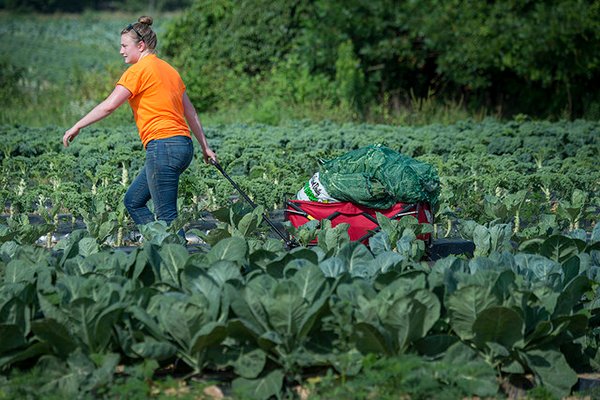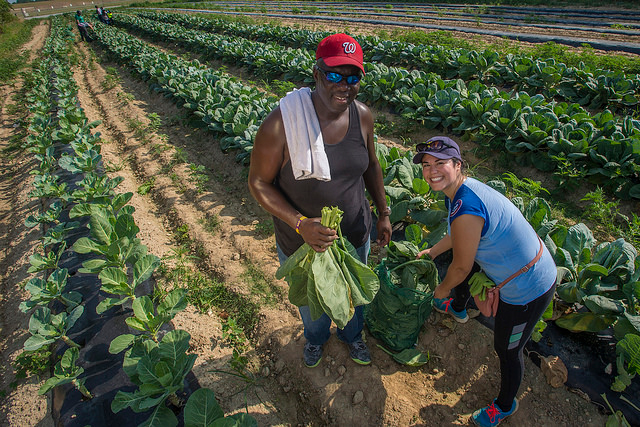Gleaning to reduce food waste and food insecurity in America

By Miguel Gómez, associate professor
According to the USDA, 30-40 percent of the total edible food produced for human consumption in the United States is lost each year. Simultaneously, more than 17 million households in the United States were food insecure at some point in 2014, meaning they did not have reliable access to a sufficient quantity of nutritious food.
We’re producing more food than we know what to do with, and yet families everywhere are suffering from malnutrition and obesity caused by food insecurity. What can we do to reduce the amount of food waste happening across the country and facilitate access to nutritious food for people who are suffering?
The relationship between food waste and food insecurity
Food waste is an issue that touches every stage of the supply chain, from production and distribution, to when food ultimately reaches consumers. In many cases, food is discarded because it is already spoiled. However, food is also wasted simply because it does not meet the cosmetic standards customers have come to expect.
Compounding the problem is that a large portion of the food wasted is precisely the food desperately needed by those suffering from food insecurity. Perishable foods such as fruits, vegetables, meat, and dairy are rich in micronutrients and critical for a healthy diet, yet they are going to waste all across our country.
Particularly in the United States, overeating and obesity are two of the most prominent health issues impacting food insecure individuals. While Americans might be consuming enough calories, many are eating inexpensive packaged foods that are rich in fat and added sugars, yet devoid of any real nutritional value.
How gleaning can reduce food waste and food insecurity
We know that about 6-7 percent of planted acreage in the United States is not harvested because of cosmetic blemishes, mechanical harvesting error, or a lack of market for the crop. Gleaning is the process of collecting leftover food products from farmers’ fields that haven’t been harvested for commercial use. The benefits of gleaning are twofold: improve the nutritional status of food insecure individuals by increasing the offering of fruits and vegetables available while simultaneously reducing food waste.

(Credit: USDA)
Through gleaning programs, volunteers are able to collect what fresh food is left in the fields after harvest and donate the goods to food banks or pantries that serve the needy. Oftentimes, food banks are oversaturated with packaged, shelf-stable foods. They are successful at getting food donations, however, these donations are not usually the type of fresh foods that make up a healthy diet. Given that the target populations served by food banks are also those experiencing food insecurity related issues, gleaning provides a wonderful opportunity to use the food bank infrastructure as a way to distribute nutrient-rich food.
Optimizing gleaning operations for better results
There are many uncertainties that can impact the effectiveness of gleaning operations. Factors such as timing of the harvest, volume of product left on the field, farmers’ willingness to donate, and availability of volunteer gleaners can all hinder operations considerably. Through our research, my colleagues and I are developing a model that food banks and pantries can use to implement more effective and efficient gleaning operations.
We are currently collaborating with the Food Bank of the Southern Tier in New York State, focusing on five major crops produced in the region to test our model. By characterizing how the gleaning operation behaves, our model allows us to optimize the gleaning schedule to maximize the expected total volume gleaned and determine under which conditions different operational strategies can be most useful for improving the performance of the gleaning operation. This in turn enables us to identify conditions under which alternative policy interventions (for example, farm donation tax credits and government grants to strengthen operational capacity) are more effective for scaling up gleaning programs.
There are two important and interrelated issues concerning healthy food production in this country—so much of it is going to waste and those who need healthy food the most don’t have access. Our research is valuable because of the societal benefits that come from reducing food waste and food insecurity. Gleaning programs are not expensive, and they provide a way for millions of people to gain access to nutritious food that already exists, but was previously inaccessible to them. I’m excited about the impact of our research, and look forward to continuing this meaningful work.
About Miguel Gómez, associate professor at the Dyson School

Miguel’s research is concentrated on two interrelated areas under the umbrella of food marketing and distribution: 1) supply chains competitiveness and sustainability and 2) retailing and channel relationships. The scope of his research program is domestic and international, the latter emphasizing food value chains in Latin America and the Caribbean. In addition, his applied research efforts aim at enhancing market opportunities for horticultural products (fruits, vegetables, and ornamentals) to benefit producers, food processors/distributors, and consumers in New York State.

1 Comment
Wayne
Part of the problem is the threat of lawsuits from recipients that may complain if they think the food isn’t good enough for them. So those who have food to give are afraid to donate. So laws have to be made to protect the rights of all parties.
Comments are closed.